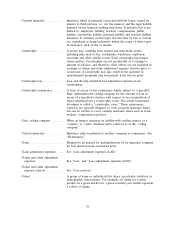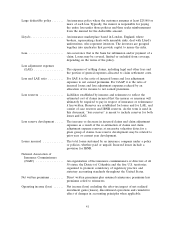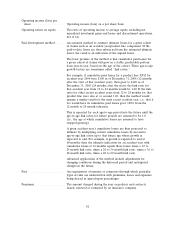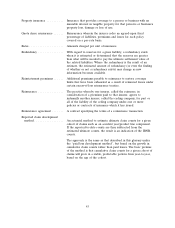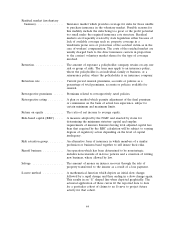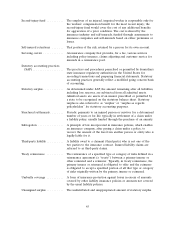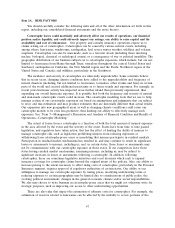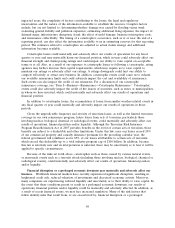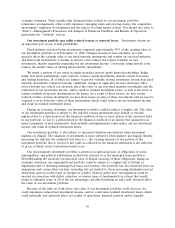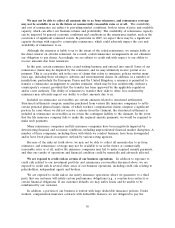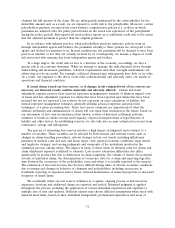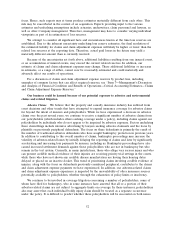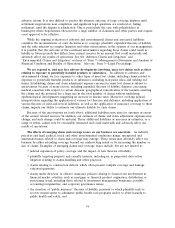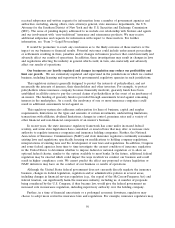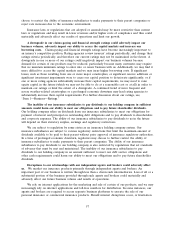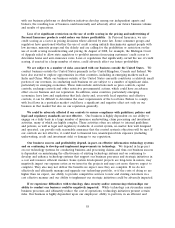Travelers 2008 Annual Report Download - page 60
Download and view the complete annual report
Please find page 60 of the 2008 Travelers annual report below. You can navigate through the pages in the report by either clicking on the pages listed below, or by using the keyword search tool below to find specific information within the annual report.impacted areas, the complexity of factors contributing to the losses, the legal and regulatory
uncertainties and the nature of the information available to establish the reserves. Complex factors
include, but are not limited to: determining whether damage was caused by flooding versus wind;
evaluating general liability and pollution exposures; estimating additional living expenses; the impact of
demand surge; infrastructure disruption; fraud; the effect of mold damage; business interruption costs;
and reinsurance collectibility. The timing of a catastrophe’s occurrence, such as at or near the end of a
reporting period, can also affect the information available to us in estimating reserves for that reporting
period. The estimates related to catastrophes are adjusted as actual claims emerge and additional
information becomes available.
Catastrophe losses could materially and adversely affect our results of operations for any fiscal
quarter or year and may materially harm our financial position, which in turn could adversely affect our
financial strength and claims-paying ratings and could impair our ability to raise capital on acceptable
terms or at all. Also, as a result of our exposure to catastrophe losses or following a catastrophe, rating
agencies may further increase their capital requirements, which may require us to raise capital to
maintain our ratings or adversely affect our ratings. A ratings downgrade could hurt our ability to
compete effectively or attract new business. In addition, catastrophic events could cause us to exhaust
our available reinsurance limits and could adversely impact the cost and availability of reinsurance.
Such events can also impact the credit of our reinsurers. For a discussion of our catastrophe
reinsurance coverage, see ‘‘Item I—Business—Reinsurance—Catastrophe Reinsurance.’’ Catastrophic
events could also adversely impact the credit of the issuers of securities, such as states or municipalities,
in whom we have invested, which could materially and adversely affect our results of operations and
financial position.
In addition to catastrophe losses, the accumulation of losses from smaller weather-related events in
any fiscal quarter or year could materially and adversely impact our results of operations in those
periods.
Given the unpredictable frequency and severity of terrorism losses, as well as the limited terrorism
coverage in our own reinsurance program, future losses from acts of terrorism, particularly those
involving nuclear, biological, chemical or radiological events, could materially and adversely affect our
results of operations, financial position and/or liquidity. Although the Terrorism Risk Insurance
Program Reauthorization Act of 2007 provides benefits in the event of certain acts of terrorism, those
benefits are subject to a deductible and other limitations. Under this law, once our losses exceed 20%
of our commercial property and casualty insurance premium for the preceding calendar year, the
federal government will reimburse us for 85% of our losses attributable to certain acts of terrorism
which exceed this deductible up to a total industry program cap of $100 billion. In addition, because
this law is relatively new and its interpretation is untested, there may be uncertainty as to how it will be
applied to specific circumstances.
Because of the risks set forth above, catastrophes such as those caused by various natural events,
or man-made events such as a terrorist attack (including those involving nuclear, biological, chemical or
radiological events), could materially and adversely affect our results of operations, financial position
and/or liquidity.
Financial disruption or a prolonged economic downturn may materially and adversely affect our
business. Worldwide financial markets have recently experienced significant disruption, resulting in
heightened credit risk, reduced valuation of investments and decreased economic activity. Moreover,
many companies are experiencing reduced liquidity and uncertainty as to their ability to raise capital. In
the event that these conditions persist or result in a prolonged economic downturn, our results of
operations, financial position and/or liquidity could be materially and adversely affected. In addition, as
a result of recent financial events, we may face increased regulation. Many of the risk factors that
follow identify risks that result from, or are exacerbated by, financial disruption or a prolonged
48


